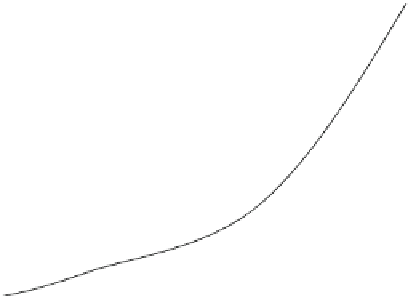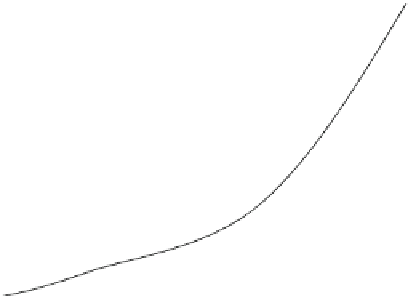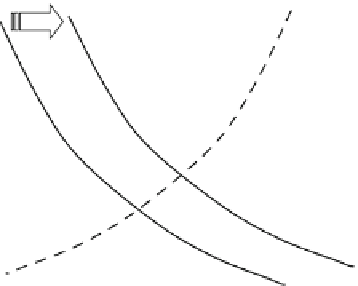Biomedical Engineering Reference
In-Depth Information
Demand shift
Total cost
Secondary costs
P
2
P
1
Primary costs
Minimum
total costs
Q
1
Q
2
Quantity
Increasing risk (decreasing safety)
Figure 8.1-4 Safety and risks associated with primary and
secondary costs. Increased safety can be gained by
considering secondary costs in product and system design.
Adapted from: M. Martin and R. Schinzinger's, 1996, Ethic in
Engineering, McGraw-Hill, New York, NY.
Figure 8.1-3 Supply-demand economic model. The increase in
demand results in a relative increase in price and quantity needed
to reach a new equilibrium point on the supply curve.
here the amount supplied equals the amount demanded.
It is a ''balance,'' as any further increase in supply would
disrupt the equilibrium. The same connotation of ''bal-
ance'' is seen in the usage of ''equilibrium'' in chemistry
and thermodynamics, which is the study of work, heat,
and energy on a system.
An object is said to be in thermodynamic equilibrium
when it is in thermal, chemical, and mechanical equi-
librium. It is observed that some properties of an object
can change when the object is heated or cooled. Should
two objects be brought into physical contact, an initial
change in the property of both objects results. For in-
stance, heat, a form of energy, is transferred between
these two objects when they are brought into contact
with one another. Eventually, this transfer of energy
stops. At this point the objects are said to be in ther-
modynamic equilibrium.
31
Thus in both the economic
and the thermodynamic definition of equilibrium, the
system is said to be in balance; nothing changes unless
acted upon by an exogenous force. In the case of market
equilibrium, these endogenous forces act to shift the
supply curve or the demand curve, subsequently chang-
ing where they cross to form the equilibrium price. Some
examples of exogenous forces are increased costs for
producers, changes in the regulatory environment, or
changes in wealth of consumers.
This supply-demand relationship is analogous to the
engineers paramount ethical demand for safety, as shown
in
Figure 8.1-4
. Like price in the economic model, the
safety of an engineered device or system translates into
costs. However, this is not a linear relationship. An
unsafe product is not cheap if all the factors are included
in the cost calculations. Primary costs of production are
only part of the equation. Premature obsolescence and
failures can lead to significant costs of lawsuits, lack of
public trust, and recalls and warranty costs.
32
A well-
designed device may still be a failure if its useful life is
too short or too uncertain.
Technological advances often improve the use of
scarce resources, which are then allocated through the
economic system. Therefore technology broadens the
horizon through which economics operates. When firms
invest, they increase capital; and increasing input means
more output, i.e., more economic growth. Depreciation
on capital stock yields less output. The term sustain-
ability in economics is similar to the concept of envi-
ronmental sustainability. In economics it is used to
describe capital withstanding time and continuing to
function to facilitate the production of output. Tech-
nology allows higher levels of sustainability for capital,
including a predictable and reliable engineered system.
We must not forget that everything engineers do is to
protect and to enhance life, no matter what the specific
discipline. Thus, even for those of us in engineering
specialties other than biomedical, we must be mindful of
our work's impact on life. And, while our keen interest is
usually in human life, we must be aware of how our work
affects other species. In fact, some of the greatest re-
sistance against scientific and engineering research is the
result of the perceived indifference to pain and suffering
in nonhuman animals. Even microbial life must be
respected in our laboratories. One of the scariest sce-
narios is that of unchecked self-replication of unicellular
species. Many engineering researchers are presently
pushing the envelopes of nanotechnology, for example.
This includes using microbes to manufacture complex
pharmaceuticals and chemical products that either
cannot be manufactured or can be manufactured much
less efficiently in abiotic chemical reactors. However,

























